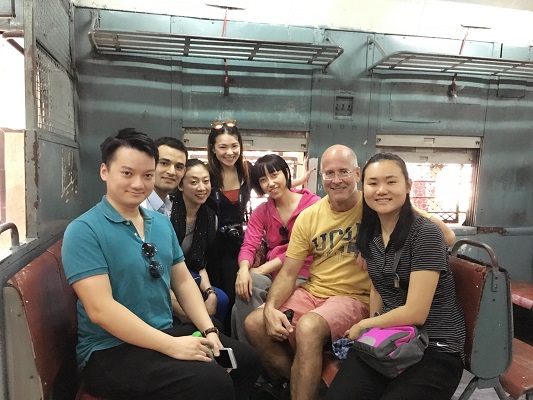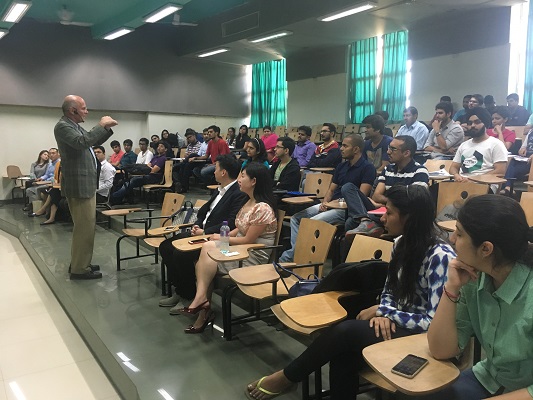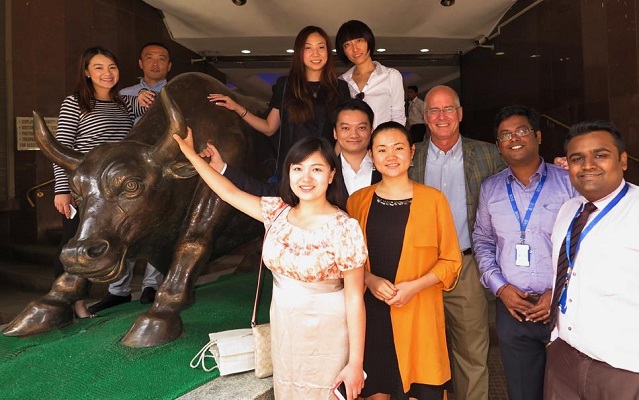Christina Chong, GMBA Class of 2016; Wanvipa (Joob) Bandidwongpaisan, GMBA Class of 2016; Ben Zeng, GMBA Class of 2017; Saowanee (Muki) Xie, GMBA Class of 2016
I. Dharavi Slum Tour by Christina Chong, GMBA Class of 2016
India has always been at the top of my list of countries to visit, and the GMBA program has given me the chance to make that dream come true. Unsure of what to expect from the trip, I travelled to Mumbai with an open mind and was excited to see the city with my own eyes.

Together with Professor Steven White, GMBA students from the Classes of 2016 and 2017 gain a deeper appreciation for the economic and social challenges facing by visiting Dharavi slum.
One of the most memorable parts of this trip for me was the slum tour. Led by Professor Steven White and our local guide, Akash, from Reality Tour, an NGO which focuses on helping local development and invests its profits in running education programs for the slum community, the group set off by train from Matunga Road station to Dharavi on the first day of the trip. With a population of more than 1 million dwelling in an area of 535 acres, the Dharavi slum is one of the largest in the world.
Walking along the crowded market, we first visited the industrial part of the slum, consisting of recycling, leather, textiles and pottery businesses which produce goods for the local market as well as export internationally. Some areas are heavily polluted due to the poisonous fumes and waste produced from burning paint, resins and metals. Following Akash through the narrow maze-like alleys, we entered into the residential area where the families of the workers live. The area had a limited supply of utilities, but the businesses and residents have learned to maximise their resources in this cluttered space.

Together with Professor Steven White, GMBA students from the Classes of 2016 and 2017 gain a deeper appreciation for the economic and social challenges facing by visiting Dharavi slum.
The 3-hour slum tour was an eye-opening and unforgettable experience. I was fascinated to see how the population has created its own ecosystem within the slum. Despite the hazardous working environment and poor living conditions, the slum is organised, the people are productive, and it was refreshing to see the children playing with smiles on their faces.
Mumbai has impressed me in so many ways: from arriving at a large modern airport, to taking city strolls surrounded by beautiful architecture, to meeting many inspiring MBA students from Somayia Vidyavihar – not to mention all the delicious Indian food. India is a country full of culture and potential, and I cannot wait to go back and explore the rest of the country.

Visit to Tata Group.
II. Visit to Tata Group by Wanvipa (Joob) Bandidwongpaisan, GMBA Class of 2016
It was a pleasure to have the opportunity to visit the Tata Group during the Mumbai trip. I have learned a great deal about the business in its home environment and the company’s strategic move outside India’s territory.
Within India, Tata is the largest corporate entity in operation since 1868, founded by Jamsetji Tata. The company operates within a number of well-known sectors across industries from agriculture services to telecom products and solutions. However, outside India, Tata has found difficulty establishing a strong local presence, particularly in China, where the emerging market is considered to be one of the largest markets for the company. To my surprise, despite the increase in revenue from its part in Jaguar & Land Rover, many locals have yet to recognize Tata as the power engine behind their success. The company has continued with great effort to establish a strong local presence, not only for higher market valuation but also for identifying top local talent to help facilitate growing demand in China.
Tata Group not only has risen within the ranks of leading global companies in its corporate responsibility but also exemplifies a well-managed family business, with Tata Sons having successfully passed through multiple generations. As a member of a family business myself, I am truly inspired by the Tata Group to develop my family’s business in a similar fashion, with the hope that it would serve its customers globally across national borders.
I learned a great deal from being proactively engaged in exchange with Tata’s representatives, especially regarding Tata’s India-China strategic move. We give special thanks to Professor White for arranging such an informative visit to the company and thank Tata’s representatives for such a warm welcome despite the national holidays.

Professor Steven White provides an overview of supply chain operations in China.
III. Mumbai Trip – Bombay Stock Exchange Visit by Ben Zeng, GMBA Class of 2017
As the next emerging market, India has been under the spotlight and has received much attention in the international community in recent years. Mumbai is the financial hub of India with two stock exchanges both located in Mumbai, the National Stock Exchange of India (NSE) and the Bombay Stock Exchange (BSE).
The Bombay Stock Exchange is the 11th largest stock exchange in the world, with an overall market capitalization of $1.7 trillion. Established in 1875, the BSE is Asia’s first stock exchange and the world’s fastest stock exchange with a median trade speed of 6 microseconds. BSE is situated in the financial community in Mumbai, where there is a no-car and no-motorcycle policy with strict security measures. There are currently 5500 companies listed on the BSE; however, foreigners are not allowed to invest or trade in the stock market. Similar to China in that respect, one would have to invest into an institutional fund in order to invest in the Indian stock market.
During our visit at the BSE, we were welcomed by a senior executive and were given a lecture from the Bombay Stock Exchange Institute. The Bombay Stock Exchange Institute is a training institution set up and led by the BSE as an initiative to cultivate financial knowledge for anyone who is interested in the Indian financial market. In early 2011, the BSE Institute launched the country’s first 2-year full-time MBA program specializing in Financial Markets.
In conclusion, the visit, led by Prof. Steven White, gave us deeper insight into the Indian stock market. As the oldest stock exchange in Asia, the stock market and the Indian economy as a whole pose great opportunity as they open their doors to foreign investments.

Trip participants visit India's top two stock markets in an endeavor to better understand the country's financial markets.
IV. SIMSR Visit by Saowanee (Muki) Xie, GMBA Class of 2016
Debraj Ghosal, the chairperson and lecturer at K.J. Somaiya Institute of Management Studies and Research (SIMSR), invited Professor White to deliver a speech on China’s economic transactions and the country’s innovative challenges. Professor White offered an overview of how supply chain works in China, factors contributing to China’s cost competitiveness and challenges in product innovation. SIMSR students showed strong interest in these topics, allowing for an insightful Q&A session afterwards. After class, a mixer was also held between Tsinghua MBA students and students from our host university, during which we further exchanged our thoughts on innovation and assisted SIMSR students in evaluating their start-up projects for the Indian and Chinese markets. We were fascinated to see start-up projects from one of the best universities in India and also thrilled at the prospect of ongoing cooperation between Tsinghua SEM and SIMSR in the near future.